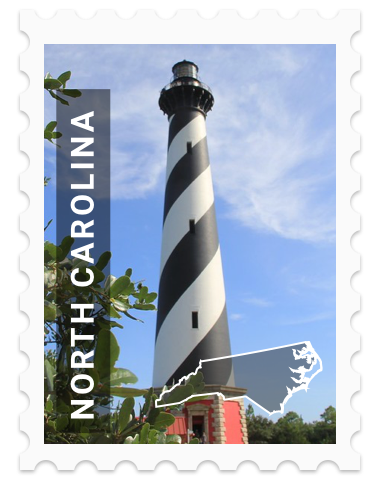Destination List > Wright Brothers Memorial
Wright Brothers Memorial
Photo by Ken Lund
The history...
Wright Brothers National Memorial, located in Kill Devil Hills, North Carolina, commemorates the first successful, sustained, powered flights in a heavier-than-air machine. From 1900 to 1903, Wilbur and Orville Wright came here from Dayton, Ohio, to have a private areas with steady winds to experiment with their flying machine.
The Wrights made four flights from level ground near the base of the hill on December 17, 1903, in the Wright Flyer, following three years of gliding experiments from atop this and other nearby sand dunes. It is possible to walk along the actual routes of the four flights, with small monuments marking their starts and finishes. Two wooden sheds, based on historic photographs, recreate the world's first airplane hangar and the brothers' living quarters.
A 60 foot (18.29 m) granite monument, dedicated in 1932, is perched atop 90-foot-tall (27 m) Kill Devil Hill, commemorating the achievement of the Wright brothers. They conducted many of their glider tests on the massive shifting dune that was later stabilized to form Kill Devil Hill. Inscribed in capital letters along the base of the memorial tower is the phrase "In commemoration of the conquest of the air by the brothers Wilbur and Orville Wright conceived by genius achieved by dauntless resolution and unconquerable faith." Atop the tower is a marine beacon, similar to one found in a lighthouse.
The doors of the tower are stainless steel over nickel, with a price of $3,000 in 1928 (equivalent to $35,818 in 2019). The six relief panels represent the conquest of the air:
Left Door (top to bottom): The contraptions of the French locksmith Besnier, who thought he could fly if he propelled himself into the air while wearing paddles on his arms and legs; An homage to Otto Lilienthal, a German who died while conducting gliding experiments; A reference to a French philosopher who thought that since dew rose in the morning, if it could be placed in an expandable bag attached to a box and sail, it would naturally rise when placed in the sun. (It didn't.)
Right Door (top to bottom): Icarus, the Greek mythological figure who tried to fly from Crete by attaching feathers to his arms with wax. He fell when he flew too close to the sun, melting the wax; Bird flight to plane flight, or the rise of a phoenix; Kites used by the Wrights and others in early experiments.
First powered flight
In camp at Kill Devil Hills, they endured weeks of delays caused by broken propeller shafts during engine tests. After the shafts were replaced, Wilbur won a coin toss and made a three-second flight attempt on December 14, 1903, stalling after takeoff and causing minor damage to the Flyer. Because December 13, 1903, was a Sunday, the brothers did not make any attempts that day, even though the weather was good, so their first powered test flight happened on the 121st anniversary of the first hot air balloon test flight that the Montgolfier brothers had done, on December 14, 1782. In a message to their family, Wilbur referred to the trial as having "only partial success", stating "the power is ample, and but for a trifling error due to lack of experience with this machine and this method of starting, the machine would undoubtedly have flown beautifully."
Following repairs, the Wrights finally took to the air on December 17, 1903, making two flights each from level ground into a freezing headwind gusting to 27 miles per hour (43 km/h). The first flight, by Orville at 10:35 am, of 120 feet (37 m) in 12 seconds, at a speed of only 6.8 miles per hour (10.9 km/h) over the ground, was recorded in a famous photograph. The next two flights covered approximately 175 and 200 feet (53 and 61 m), by Wilbur and Orville respectively. Their altitude was about 10 feet (3.0 m) above the ground. The following is Orville Wright's account of the final flight of the day:
Wilbur started the fourth and last flight at just about 12 o'clock. The first few hundred feet were up and down, as before, but by the time three hundred ft had been covered, the machine was under much better control. The course for the next four or five hundred feet had but little undulation. However, when out about eight hundred feet the machine began pitching again, and, in one of its darts downward, struck the ground. The distance over the ground was measured to be 852 feet; the time of the flight was 59 seconds. The frame supporting the front rudder was badly broken, but the main part of the machine was not injured at all. We estimated that the machine could be put in condition for flight again in about a day or two.
Wikipedia - Memorial and Wright Brothers





